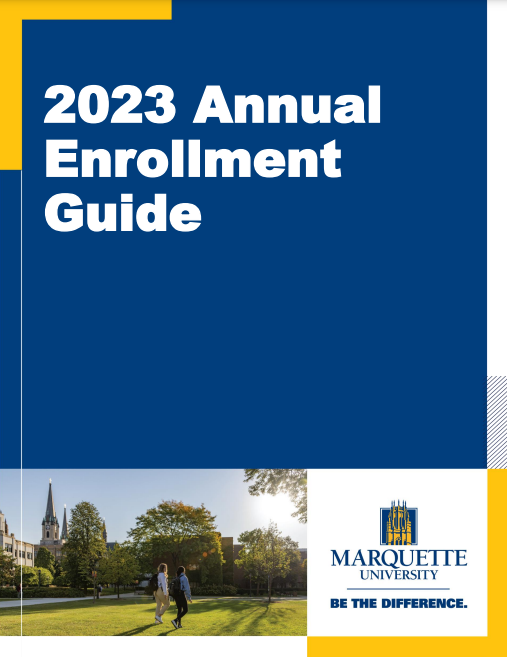Q12. Why are we seeing health care cost increases for 2023?
A12. While you’ll see increased medical and dental plan premium increases for 2023, we know there is little solace in knowing “you’re not alone.” Marquette University was able to hold premiums constant from 2021 to 2022, but there are a number of factors contributing to increased health care costs. Many people delayed routine and diagnostic medical appointments due to COVID-19, resulting in more advanced medical needs and treatments. The backlog of elective surgeries and procedures previously postponed due to the pandemic is now being cleared. New specialty drugs continue to be brought to the market, and those come at a high cost. Lastly, general inflation affects many goods and services, of which health care is one of them. Over the years, Marquette has made strides in helping members manage their health care cost and therapies. Some of the most recent enhancements to help plan members manage their health care treatment and spending include:
- Partnering with Tria Health in 2022. Tria Health helps members manage their chronic conditions with drug therapies that provide the best care for their condition at a cost-effective price.
- Introducing My Wellness — a program focused on your health and well-being.
- Offering (in 2023) members the ability to use services of 2nd.MD, an organization that provides second opinions to ensure you are undergoing the appropriate treatment for your condition.
- Offering (in 2023) a new 6 for $6 pharmacy benefit, allowing members to receive a six-month supply of certain prescriptions for only $6.
- Contracting with a new Employee Assistance Program (EAP) called LifeMatters. LifeMatters provides free counseling and work/life services 24/7/365 to all employees, covered dependents, and members of employee’s immediate household, including students who are away at school.
- Continuing to offer free preventive care visits across all plans. Early detection and treatment of health conditions remains the best way to manage one’s health.
Q13. How does Marquette University prepare for annual enrollment? What does Marquette do to evaluate plan options every year?
A13. As soon as the new year begins, Marquette’s Human Resources team and the Health Care Task Force hit the ground running to begin planning for the following year. They work closely with an external Benefits Consulting firm for guidance on trends, to evaluate Marquette’s plans’ costs, and to learn about innovative ideas on how to contain costs (for employees and the university) while maintaining high-quality care. Several of the new programs you’ve learned about over the last few years were the result of those efforts.
By using a Benefits Consultant, we are able to benchmark how Marquette’s plans compare to other local organizations, the consultant’s entire Book of Business, and similar sized colleges and universities.
The plans offered by Marquette are self-funded, meaning that Marquette and our plan participants (through premiums, deductibles, co-insurance, etc.) pay for the cost of the benefits. Actual claims paid, along with administrative costs to manage member’s care, are analyzed and used to set premiums for the next year. For that reason alone, we all need to be good stewards of the health care system to ensure we get the right care at the right time at the most appropriate place, and to avoid waste when possible.
Q14. Who is Tria Health?
A14. Tria Health is a vendor that provides condition management services to medical plan members with diabetes, heart disease, high cholesterol, high blood pressure, mental health disorders, asthma/COPD, osteoporosis, or migraines. This is a free and confidential service. Tria Health will identify members through medical and prescription drug claims data and will reach out to them directly to invite them into the program. Members who actively participate in the program will have an opportunity to receive discounted medications and equipment for managing specific chronic conditions. In addition, any member who has questions about their medications can call Tria to ask questions about the efficacy of their prescription drugs, drug interactions, or if there are other more cost-effective drugs.
Q15. How can 2nd.MD program help?
A15. Coming in 2023. Marquette partnered with 2nd.MD to offer members enrolled in the Marquette medical plans an opportunity to access to specialist who can provide a second opinion when you are faced with decisions about a treatment plan for your condition.
Through a medical consultation and navigation service, you can connect with a board-certified, elite specialist for a virtual expert medical consultation via phone or video from the comfort of home.
2nd.MD specializes in medical certainty by providing access to elite specialists for questions about:
- Diseases, cancer, or chronic conditions
- Surgeries or procedures
- Medications and treatment plans
The Plan still offers you the ability to seek a second opinion from a provider of your choosing; however, 2nd.MD has experts in many specialties, so you may want to learn more about how they can help you – and at no cost to you.
Q16. Do I need to be a member of Costco to take advantage of the 6 for $6 program?
A16. No, you do not need to be a Costco member to use this program. Marquette took advantage of this offering for its medical plan members through a partnership between Navitus and Costco. There are several different drug therapies that will be offered at $6 for a six-month supply at Costco stores. View drugs and their strengths offered through this program.
Q17. Where can I find a UnitedHealthcare Premium Designated Provider?
A17. Go to “umr.com” and select the “Find a provider” tile on the lower left side of the home screen. You can also call the number on the back of your health plan ID card. Premium Designated Providers can be identified with two blue hearts alongside their name.
Q18. What are the advantages of using a UnitedHealthcare Premium Designated Provider?
A18. Where you get care is your personal choice. No two doctors are exactly alike, and you probably think about many factors when choosing a doctor. The UnitedHealth Premium designation can help you make more informed and confident health care decisions.
If you need help in selecting a new doctor, outpatient facility or hospital, let UMR help you find a provider with two Blue Hearts, indicating they provide high quality results.
With these providers, you’re more likely to get the care you need the first time, at the right place. That means:
- Fewer complications.
- Fewer do-over surgeries.
- Fewer unnecessary lab tests, MRIs and medications.
Call the number on the back of your UMR member ID card to get connected to a provider near you. Or search for one by logging into the UMR website at umr.com on your computer or mobile device.
Q.19. Do my medical plan premiums count towards my deductible and out-of-pocket maximums?
A19. No. The expenses that do apply to your deductible and out-of-pocket maximum are your out-of-pocket costs such as copayments and coinsurance amounts.
Q20. How can I determine what medical plan is best for me?
A20. First, know that all three medical plans are identical in the covered services provided, the national provider network, and include coverage for wellness and preventive care in-network at 100%. The only differences between the plans are premiums, deductibles, copays and out-of-pocket maximums. If you want to allocate pre-tax dollars for health care expenses, read more about FSAs and HSAs.
There are a variety of resources to help you make a good decision for your personal situation:
- Scheduling a 30-minute appointment with a Benefits Educator by calling 1-877-759-7668.
- Use the “Ask Emma” tool on the benefits enrollment system.
- Referring to the Health Plan Personas examples in the Annual Benefits Enrollment Guide.
- Call a UMR Plan Advisor (number here) to discuss procedures planned for next year
Q21. Can you clarify how the dental plan deductible works for families?
A21. The per person deductible in the dental plan is $50. Once an individual satisfies the deductible, that person’s future claims are paid at the set coinsurance levels until the individual annual maximum plan benefit of $2,500 is reached. The maximum family deductible in the dental plan is $150. If three or more family members meet a total deductible of $150 in the Plan Year, the family’s claims from that point on through the end of the Plan Year will be covered at the coinsurance levels based on the type of service up to each person’s annual maximum benefit of $2,500 each.

